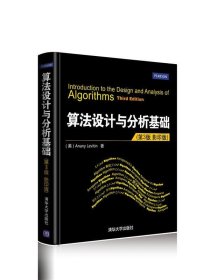
算法设计与分析基础
¥ 9 1.1折 ¥ 79 九五品
仅1件
作者(美)莱维丁
出版社清华大学出版社
ISBN9787302311850
出版时间2013-05
版次1
装帧平装
开本16开
纸张胶版纸
页数565页
字数99999千字
定价79元
上书时间2024-04-25
- 最新上架
商品详情
- 品相描述:九五品
- 商品描述
-
基本信息
书名:算法设计与分析基础
定价:79.00元
作者:(美)莱维丁
出版社:清华大学出版社
出版日期:2013-05-01
ISBN:9787302311850
字数:1047000
页码:565
版次:1
装帧:平装
开本:12开
商品重量:
编辑推荐
算法是思维的艺术,是数学之美的体现,是计算机和信息科学的灵魂,更是优秀程序员的安身立命之本。本书将算法视为解决问题的工具,通过作者的、具有里程碑意义的新型分类法弥补了传统算法设计技术分类法的缺陷,用深入浅出的语言和新颖的实例与谜题,诠释了何为算法、算法的分类、算法幕后的思想、算法的效率,抽丝剥茧、条分缕析地探索了算法设计与分析过程。 本书,本书起到了很好的作用用全新的方式通过谜题和游戏来开拓算法思维,既适合本科生和研究生教学,又适合程序员参考,是帮助他们享受算法的乐趣,领悟思维训练之美,提升编程能力的理想读物。(1)从科学性和专业性来讲,作者将原来不受重视的一些算法设计策略(如蛮力法、减治法、变治法、时空权衡和迭代改进)等纳入其中,覆盖了更多传统方法无法分类的经典算法(如欧几里得算法、堆排序、查找树、散列法、拓扑排序、高斯消去法、霍钠法则等),甚至还纳入了一些重要算法设计方法的变种。(2)从系统性来讲,有趣的是,本书采用的正是算法的经典模式,首先说明什么是算法,然后经过思维训练和实践,解决如何分析与设计算法。这一点而言,对学生的真正意义在于,学会用思维能力和创新能力来解决问题,为日后的职业生涯打下坚实的基础。(3)从适用性来讲,本书跳出了传统教材的框架,用一种新颖的方式来呈现主题,既照顾了本科学生课堂教学的需求,也兼顾了让他们课后拓展学习,进一步探索算法奥秘的愿望,具有广泛的普适性。(4)从创新性来讲,本书的分类框架条理清晰,符合计算机教育的原理,非常适合算法教学,大量的流行谜题和游戏,让人流连忘返,手不释卷。 经过近5年的教学实践,本书版和第2版被证明是算法课程中具有较高价值的经典教材,据不完全统计,选用本书的学校包括清华大学、复旦大学、中国矿业大学、上海交通大学、解放军理工大学、广西大学、华南理工大学、安徽工业大学、广东工业大学、西安建筑科技大学,广东理工大学,齐齐哈尔大学、南昌航空工业学院软件学院、解放军炮兵学院、绵阳师范学院、湘潭大学、徐州工程学院、广东工业大学、广东工业大学、沈阳工业大学、西南科技大学、上海工程技术大学、湖南商学院、炮兵学院基础部、江西财经大学、华北科技学院、中南民族大学、沈阳建筑大学、北京第二外国语学院教育技术中心、潍坊学院、西华大学、武汉理工大学、河南师范大学、无锡科技职业学院、安徽理工大学、浙江工商大学、肇庆学院等。
内容提要
本书在讲述算法设计技术时采用了新的分类方法,在讨论分析方法时条分缕析,形成了连贯有序、耳目一新的风格。为便于学生掌握,本书涵盖算法入门课程的全部内容,更注重对概念(而非形式)的理解。书中通过一些流行的谜题来激发学生的兴趣,帮助他们加强和提高解决算法问题的能力。每章小结、习题提示和详细解答,形成了非常鲜明的教学特色。 本书特色: 独辟蹊径,采用一种更全面的算法设计技术分类方法 涵盖递归与非递归算法的数学分析,也涉及经验分析和算法可视化 探讨算法的局限性及解决方法 将算法视为解决问题的工具,通过谜题和游戏来开拓算法思维 为学生提供600多道习题(含提示),为教师提供有详细解答的教师手册 本书适用于以下课程: 算法(计算机科学) C 算法(计算机科学) Java—算法(计算机科学) C算法(计算机科学) C算法/数据结构高级课程(计算机科学) Java-算法/数据结构高级课程(计算机科学) C --算法/数据结构高级课程(计算机科学) Previous Editions Levitin ISBN-10: 0321358287 ? ISBN-13:9780321358288 ©2007 ? Paper, 592 pp ? Out ofPrint More info ……
目录
Table ofContentsNew tothe Third Edition xviiPrefacex1Introduction1.1 WhatIs an Algorithm?Exercises1.11.2Fundamentals of Algorithmic Problem SolvingUnderstanding theProblemAscertaining theCapabilities of the Computational DeviceChoosingbetween Exact and Appromate ProblemSolvingAlgorithmDesign TechniquesDesigningan Algorithm and Data StructuresMethodsof Specifying an AlgorithmProvingan Algorithm’s CorrectnessAnalyzingan AlgorithmCoding anAlgorithmExercises1.21.3Important Problem TypesSortingSearchingStringProcessingGraphProblemsCombinatorialProblemsGeometricProblemsNumericalProblemsExercises1.31.4Fundamental Data StructuresLinearData StructuresGraphsTreesSets andDictionariesExercises1.4Summary2Fundamentals of the Analysis of AlgorithmEfficiency2.1 TheAnalysis FrameworkMeasuringan Input’s SizeUnits forMeasuring Running TimeOrders ofGrowthWorst-Case, Best-Case, andAverage-Case EfficienciesRecapitulation of theAnalysis FrameworkExercises2.12.2Asymptotic Notations and Basic EfficiencyClassesInformalIntroductionO-notation-notation-notationUsefulProperty Involving the Asymptotic NotationsUsingLimits for Comparing Orders of GrowthBasicEfficiency ClassesExercises2.22.3Mathematical Analysis of NonrecursiveAlgorithmsExercises2.32.4Mathematical Analysis of RecursiveAlgorithmsExercises2.42.5Example: Computing the nth Fibonacci NumberExercises2.52.6Empirical Analysis of AlgorithmsExercises2.62.7Algorithm VisualizationSummary3 BruteForce and Exhaustive Search3.1Selection Sort and Bubble SortSelectionSortBubbleSortExercises3.13.2Sequential Search and Brute-Force StringMatchingSequentialSearchBrute-Force StringMatchingExercises3.23.3Closest-Pair and Convex-Hull Problems by BruteForceClosest-PairProblemConvex-HullProblemExercises3.33.4Exhaustive SearchTravelingSalesman ProblemKnapsackProblemAssignmentProblemExercises3.43.5Depth-First Search and Breadth-First SearchDepth-FirstSearchBreadth-FirstSearchExercises3.5Summary4Decrease-and-Conquer4.1Insertion SortExercises4.14.2Topological SortingExercises4.24.3Algorithms for Generating CombinatorialObjectsGeneratingPermutationsGeneratingSubsetsExercises4.34.4Decrease-by-a-Constant-Factor AlgorithmsBinarySearchFake-CoinProblemRussianPeasant MultiplicationJosephusProblemExercises4.44.5Variable-Size-Decrease AlgorithmsComputinga Median and the Selection ProblemInterpolationSearchSearchingand Insertion in a Binary Search TreeThe Gameof NimExercises4.5Summary5Divide-and-Conquer5.1MergesortExercises5.15.2QuicksortExercises5.25.3Binary Tree Traversals and RelatedPropertiesExercises5.35.4Multiplication of Large Integers andStrassen’s MatrixMultiplicationMultiplication of LargeIntegersStrassen’s MatrixMultiplicationExercises5.45.5 TheClosest-Pair and Convex-Hull ProblemsbyDivide-and-ConquerTheClosest-Pair ProblemConvex-HullProblemExercises5.5Summary6Transform-and-Conquer6.1PresortingExercises6.16.2Gaussian EliminationLUDecompositionComputinga Matrix InverseComputinga DeterminantExercises6.26.3Balanced Search TreesAVLTrees2-3TreesExercises6.36.4 Heapsand HeapsortNotion ofthe HeapHeapsortExercises6.46.5Horner’s Rule and Binary ExponentiationHorner’sRuleBinaryExponentiationExercises6.56.6Problem ReductionComputingthe Least Common MultipleCountingPaths in a GraphReductionof Optimization ProblemsLinearProgrammingReductionto Graph ProblemsExercises6.6Summary7 Spaceand Time Trade-Offs7.1Sorting by CountingExercises7.17.2 InputEnhancement in String MatchingHorspool’sAlgorithmBoyer-MooreAlgorithmExercises7.27.3HashingOpenHashing (Separate Chaining)ClosedHashing (Open Addressing)Exercises7.37.4B-TreesExercises7.4Summary8 DynamicProgramming8.1 ThreeBasic ExamplesExercises8.18.2 TheKnapsack Problem and Memory FunctionsMemoryFunctionsExercises8.28.3Optimal Binary Search TreesExercises8.38.4Warshall’s and Floyd’s AlgorithmsWarshall’sAlgorithmFloyd’sAlgorithm for the All-Pairs Shortest-PathsProblemExercises8.4Summary9 GreedyTechnique9.1Prim’s AlgorithmExercises9.19.2Kruskal’s AlgorithmDisjointSubsets and Union-Find AlgorithmsExercises9.29.3Dijkstra’s AlgorithmExercises9.39.4Huffman Trees and CodesExercises9.4Summary10Iterative Improvement10.1 TheSimplex MethodGeometricInterpretation of Linear ProgrammingAnOutline of the Simplex MethodFurtherNotes on the Simplex MethodExercises10.110.2 TheMamum-Flow ProblemExercises10.210.3Mamum Matching in Bipartite GraphsExercises10.310.4 TheStable Marriage ProblemExercises10.4Summary11Limitations of Algorithm Power11.1Lower-Bound ArgumentsTrivialLower BoundsInformation-TheoreticArgumentsAdversaryArgumentsProblemReductionExercises11.111.2Decision TreesDecisionTrees for SortingDecisionTrees for Searching a Sorted ArrayExercises11.211.3 P,NP, and NP-Complete ProblemsP and NPProblemsNP-CompleteProblemsExercises11.311.4Challenges of Numerical AlgorithmsExercises11.4Summary12 Copingwith the Limitations of Algorithm Power12.1Backtrackingn-QueensProblemHamiltonian CircuitProblemSubset-SumProblemGeneralRemarksExercises12.112.2Branch-and-BoundAssignmentProblemKnapsackProblemTravelingSalesman ProblemExercises12.212.3Appromation Algorithms for NP-HardProblemsAppromation Algorithmsfor the Traveling Salesman ProblemAppromation Algorithmsfor the Knapsack ProblemExercises12.312.4Algorithms for Solving Nonlinear EquationsBisectionMethodMethod ofFalse PositionNewton’sMethodExercises12.4SummaryEpilogueAPPENDIXAUsefulFormulas for the Analysis of AlgorithmsProperties ofLogarithmsCombinatoricsImportantSummation FormulasSumManipulation RulesAppromation of a Sum bya Definite IntegralFloor andCeiling FormulasMiscellaneousAPPENDIXBShortTutorial on Recurrence RelationsSequencesand Recurrence RelationsMethodsfor Solving Recurrence RelationsCommonRecurrence Types in Algorithm AnalysisReferencesHints toExercisesIndex
作者介绍
AnanyLevitin教授,维拉诺瓦大学毕业于莫斯科国立大学并获得数学硕士学位。他拥有耶路撒冷希伯来大学数学博士学位和美国肯塔基大学计算机科学硕士学位。他的著作《算法设计与分析基础》已经被翻译为中文、俄文、希腊文和韩文,并被全球数百所高校广泛用作教材。目前,Levitin博士在美国维拉诺瓦大学讲授“算法设计与分析”课程。他的另一本著作《算法谜题》已经于2011年秋出版。Anany Levitin,美籍犹太人,维拉诺瓦大学(Villanova)计算机科学系教授。他的论文“算法设计技术新途径:弥补传统分类法的缺憾”(ANew Road Mpa of Algorithm Design Techniques: Picking Up Where theTraditional Classfication Leaves Off)深受业内好评,并享有广泛的声誉。他提出的这种新分类方法涵盖众多经典算法,开创了传统分类无法以一致方式介绍这些算法的先河。作为通用的问题解决工具,算法设计技术的应用很广,尤其适用于解决“狼,羊,白菜”问题和旅行商问题之类的流行谜题。因为他对算法教育所做出的杰出贡献,Levitin教授曾多次受邀在SIGCSE(Computer Science Education,计算机教育)全球大会上发表演讲,此大会每三年才举行一次。Anany Levitin教授目前的研究课题为“Do We Teachthe Right Algorithm Design Techniques ?”
序言
-

【封面】
— 没有更多了 —











以下为对购买帮助不大的评价